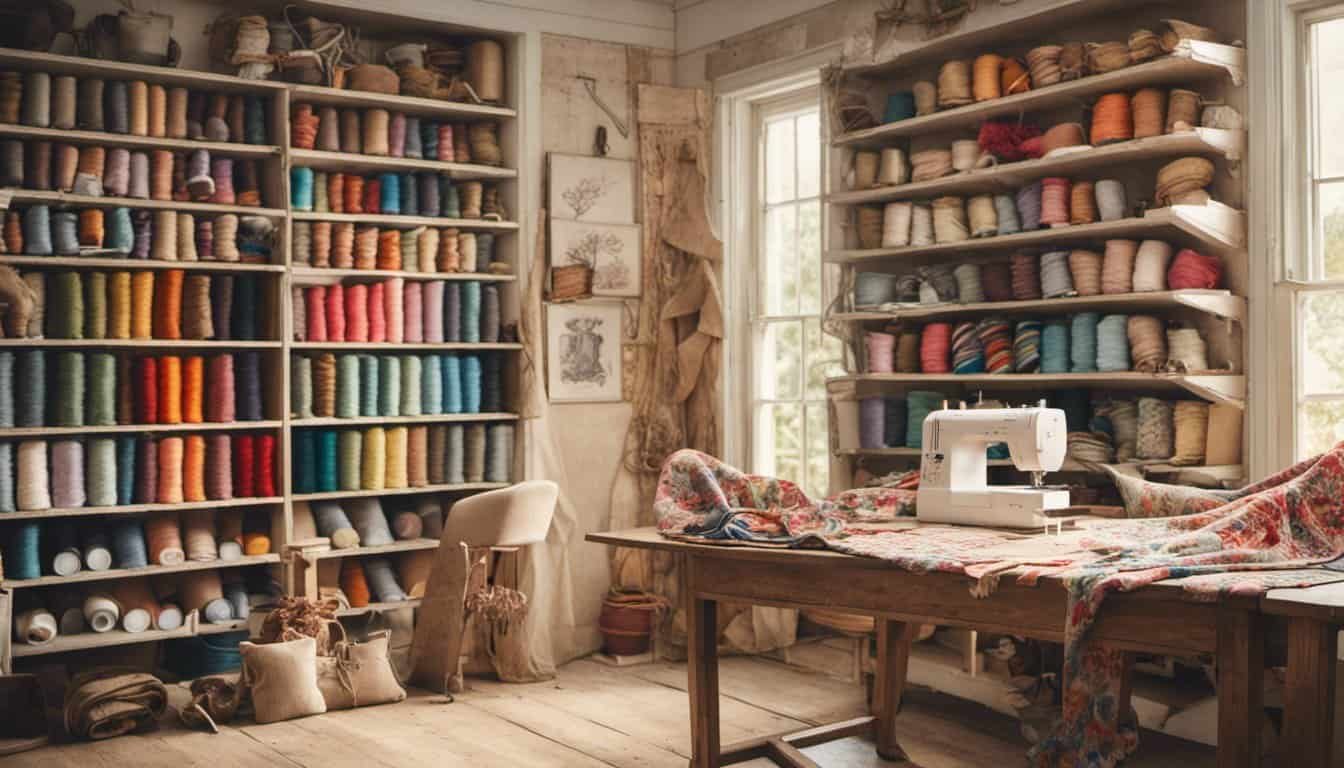Adding a scalloped hem can transform a simple garment into something truly special. I’ve always loved the delicate, flowing lines that a scalloped edge brings to fabrics, giving them a touch of elegance and charm. Whether you’re updating your favorite dress or crafting a unique home decor piece, mastering this technique with a sewing machine opens up endless creative possibilities.
Tools And Materials Needed
- Sewing Machine: A reliable machine with adjustable stitch settings.
- Scallop Edge Presser Foot: Designed for creating precise scalloped patterns.
- Fabric: The garment or project fabric, pre-washed and pre-shrunk.
- Thread: Color-matched polyester or cotton thread for durability.
- Pins or Clips: To hold fabric layers securely in place.
- Measuring Tape: For accurate measurements and spacing.
- Rotary Cutter and Cutting Mat: For precise cutting of fabric edges.
Preparing Your Fabric
Before sewing a scalloped hem, proper fabric preparation ensures clean and professional results. Here are the key steps I follow:
Pre-Wash the Fabric
I always pre-wash my fabric to prevent shrinkage after the hem is sewn. Use the appropriate water temperature and wash cycle recommended for your fabric type. Dry the fabric completely before proceeding.
Iron the Fabric
Press the fabric to eliminate wrinkles. A smooth surface is essential for accurate hem stitching. I use a steam iron on the suitable heat setting for my fabric.
Measure and Mark the Hemline
Accurate measurements are crucial for a symmetrical scalloped edge. I use a measuring tape to determine the desired hem length and mark the fabric with fabric chalk or a washable marker. Ensuring consistent markings helps maintain even scallops.
Prepare the Fabric Edges
If the fabric frays easily, I apply a fabric stabilizer or use pinking shears to finish the edges. This step prevents unraveling and maintains the integrity of the scalloped hem.
Cut to Size
Using a rotary cutter and cutting mat, I trim the fabric along the marked lines. Precise cutting ensures that the scalloped pattern aligns correctly with the fabric edges.
Gather Necessary Tools
I gather all essential tools, including the scallop edge presser foot, matching thread, pins or clips, and measuring tape. Having everything ready streamlines the sewing process and keeps me organized.
Test on Scrap Fabric
Before working on the actual garment, I test the scalloped hem on a scrap piece of fabric. This practice run allows me to adjust settings and ensure the pattern looks as intended.
By following these preparation steps, I set the foundation for a flawless scalloped hem. Proper fabric preparation not only enhances the appearance but also makes the sewing process smoother and more efficient.
Setting Up Your Sewing Machine
Properly setting up your sewing machine ensures smooth stitching and flawless scalloped hems. Here’s how to get started.
Choosing The Right Presser Foot
Selecting the correct presser foot is crucial for creating scalloped hems. I use a scallop edge presser foot, which guides the fabric along a scalloped template. This foot type maintains consistent spacing and curves, essential for a professional finish. Ensure the presser foot is compatible with your sewing machine model by checking the manufacturer’s specifications. Additionally, clean the presser foot regularly to prevent fabric buildup, which can disrupt stitching accuracy.
Adjusting Stitch Settings
Fine-tuning your stitch settings guarantees precise scalloped edges. First, set your machine to a straight stitch with a medium stitch length, typically around 2.5 mm. Adjust the stitch width to match the scallop design, usually between 0.5 to 1.0 mm. I increase the tension slightly to accommodate thicker fabrics, preventing puckering. Test these settings on a fabric scrap before sewing the actual garment. This practice helps identify any adjustments needed for optimal stitch formation and ensures your scalloped hem turns out perfectly.
Sewing The Scalloped Hem
Sewing a scalloped hem adds a stylish touch to your garments. Here’s how I create and sew the perfect scalloped edge.

Creating A Template
To ensure consistent scallops, I start by making a template:
- Determine Scallop Size: Measure the desired scallop width, typically between 1/2 to 1 inch.
- Draw the Curve: On a piece of cardboard, draw a series of connected semicircles matching the scallop size.
- Cut the Template: Carefully cut out the scallop shape to use as a guide.
- Secure the Template: Pin the template to the fabric edge, ensuring even spacing.
This template helps maintain uniform curves across the hem, ensuring a professional finish.
Sewing Along The Curve
With the template in place, I proceed to sew the scalloped hem:
- Attach the Presser Foot: Use a scallop edge presser foot for better guidance along the template.
- Set Stitch Length and Width: Adjust to a medium straight stitch length (about 2.5 mm) and a stitch width that complements the scallop design.
- Start Sewing: Guide the fabric along the template, keeping the presser foot aligned with the curve.
- Maintain Tension: Ensure consistent tension to prevent puckering or loose stitches.
- Secure the Stitch: Backstitch at the beginning and end of each scallop to reinforce the seam.
By following these steps, I achieve smooth, evenly spaced scalloped hems that enhance any garment.
Finishing Touches
After sewing the scalloped hem, I focus on refining the details to ensure a professional look.
Pressing the Hem
« You Won’t Believe How Easy It Is to Sew a Flap Pocket for Jackets
How to Sew a Straight Stitch with a Machine: 7 Expert Tips for Perfect Results »
Pressing is crucial for a crisp finish. I use an iron set to the appropriate temperature for the fabric type.
- Press the scalloped edge to flatten stitches and enhance the curve.
- Steam gently to remove any remaining wrinkles without distorting the scallop.
- Press both the right and wrong sides for a polished appearance.
Trimming Excess Threads
Removing excess threads prevents unraveling and maintains a neat edge.
- Snip threads close to the seam allowance using sharp scissors.
- Check all stitches to ensure no loose ends remain.
- Trim carefully around the scalloped pattern to avoid cutting the edge.
Final Inspection
A thorough inspection catches any missed details.
- Examine the scalloped hem for even spacing and consistent curves.
- Adjust any uneven areas by re-sewing if necessary.
- Confirm that the hem is securely fastened and free from puckering.
Optional Embellishments
Adding simple embellishments can enhance the hem’s appearance.
- Apply decorative trims or lace along the scalloped edge for extra flair.
- Use matching thread to add subtle embroidery if desired.
- Incorporate contrasting colors to highlight the scalloped design.
Maintenance Tips
Proper maintenance extends the hem’s lifespan.

- Wash garments inside out to protect the scalloped hem from abrasion.
- Iron on low heat to avoid damaging the scalloped stitches.
- Store items carefully to prevent creasing or stretching of the hem.
By completing these finishing touches, I achieve a beautifully scalloped hem that elevates any garment’s style and craftsmanship.
Conclusion
Seeing that scalloped hem come together on my fabric always feels rewarding. It’s amazing how a simple detail can transform a piece into something special. I love the delicate touch it adds to my creations and how it opens up new possibilities for design.
Trying out this technique might seem daunting at first but once you get the hang of it the results are worth every effort. Keep practicing and don’t be afraid to experiment with different fabrics and sizes. Each project helps you improve and discover your unique style.
Happy sewing and enjoy adding those beautiful scalloped edges to your favorite garments!


















